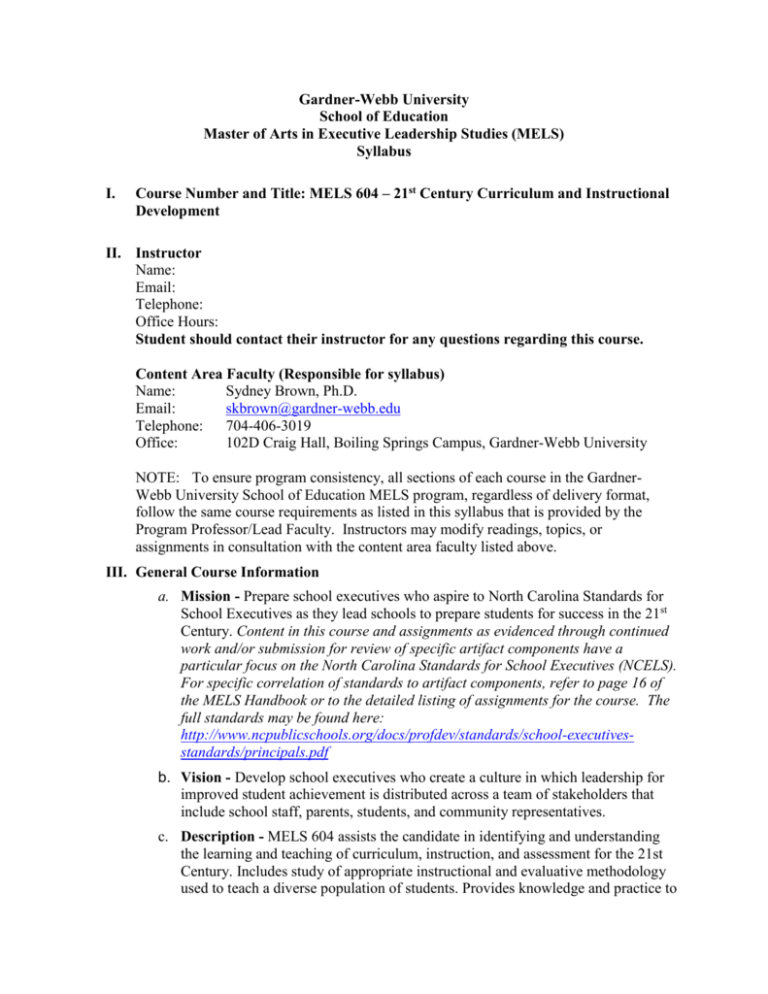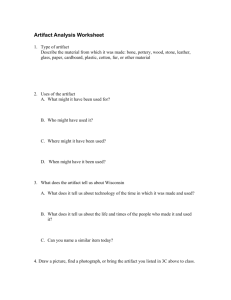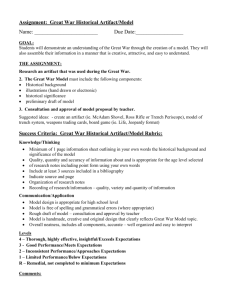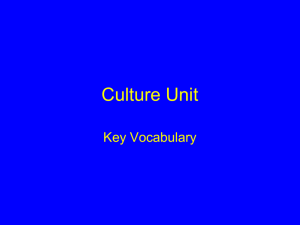MELS 604 syll 7-12-12
advertisement

Gardner-Webb University School of Education Master of Arts in Executive Leadership Studies (MELS) Syllabus I. Course Number and Title: MELS 604 – 21st Century Curriculum and Instructional Development II. Instructor Name: Email: Telephone: Office Hours: Student should contact their instructor for any questions regarding this course. Content Area Faculty (Responsible for syllabus) Name: Sydney Brown, Ph.D. Email: skbrown@gardner-webb.edu Telephone: 704-406-3019 Office: 102D Craig Hall, Boiling Springs Campus, Gardner-Webb University NOTE: To ensure program consistency, all sections of each course in the GardnerWebb University School of Education MELS program, regardless of delivery format, follow the same course requirements as listed in this syllabus that is provided by the Program Professor/Lead Faculty. Instructors may modify readings, topics, or assignments in consultation with the content area faculty listed above. III. General Course Information a. Mission - Prepare school executives who aspire to North Carolina Standards for School Executives as they lead schools to prepare students for success in the 21st Century. Content in this course and assignments as evidenced through continued work and/or submission for review of specific artifact components have a particular focus on the North Carolina Standards for School Executives (NCELS). For specific correlation of standards to artifact components, refer to page 16 of the MELS Handbook or to the detailed listing of assignments for the course. The full standards may be found here: http://www.ncpublicschools.org/docs/profdev/standards/school-executivesstandards/principals.pdf b. Vision - Develop school executives who create a culture in which leadership for improved student achievement is distributed across a team of stakeholders that include school staff, parents, students, and community representatives. c. Description - MELS 604 assists the candidate in identifying and understanding the learning and teaching of curriculum, instruction, and assessment for the 21st Century. Includes study of appropriate instructional and evaluative methodology used to teach a diverse population of students. Provides knowledge and practice to Executive Leadership candidates in guiding teachers in effective models and strategies for teaching all students to a high level of achievement. The course includes an emphasis on differentiation of instruction for specific student populations. d. Rationale - Leaders within 21st century schools are expected to create collaborative cultures focused on student learning and including students, parents, and community stakeholders in addition to school staff. By developing a thorough understanding of the field of curriculum and instruction, the school executive can facilitate the consideration of research-based best practices as curricular choices and build consensus among various stakeholders based on a broader understanding of the alternatives available and the rationale supporting those alternatives. A continued goal in public education is to improve student learning within respectful educational environments. Through study and application of research-based models of teaching, future executive leaders expand their knowledge of differentiating instruction based on specific needs and preferences of learners matched to characteristics of content and learning skills. e. Goals/Objectives – By the end of the course, the future executive leader will: 1. Continue work with their PLC in researching best instructional practices related to specific site needs (Artifact 1C; NCELS 1c, 2a, 6b). 2. Continue reflective journaling related to the process of working with their PLC on analyzing data and developing an action plan related to student learning and development (Artifact 1D; NCELS 5b) 3. Begin work on constructing a collaboratively developed, formal action plan related to improving student learning based on site-specific data (Artifact 1E; NCELS 1c, 2a, 3c, 4a, 5b). 4. Work with others to utilize research conducted on teacher empowerment and leadership to develop a visual checklist of best practices and engage in the implementation of best practices at their site (Artifact 2B; NCELS 3d). 5. Work with others to conduct a gap analysis comparing researched best practices on teacher empowerment and leadership to actual site-specific practices through teacher observation and other forms of documentation (Artifact 2C; NCELS 3d, 4c). 6. Analyze findings from comparison of research findings and site-specific practices to identify opportunities for teacher empowerment within the candidate’s site and work with others to empower teachers to close identified gap/s (Artifact 2D; NCELS 1d, 3d, 4a). 7. Collaborate with PLC members to create a formal action plan targeting identified opportunities for teacher empowerment and student learning (Artifact 2E; NCELS 1d, 3d, 4a, 4b, 4c). 8. Complete and submit for evaluation on TaskStream the Stakeholder Involvement Plan (SIP) for their school site (Artifact 3; NCELS 6a, 3a, 5c). 9. Continue work of gathering qualitative data through observation and interview for use in creating a rich description of the school setting (Artifact 5C; NCELS 3b, 3d, 7a) 10. Continue work assessing the level of cultural competence of various facets of the school setting (Artifact 5D; NCELS 3b, 3d, 7a) 11. Collaborate with stakeholders (both internal and external to the school site) to review findings of disaggregation of school data and climate survey (ie Teacher Working Conditions Survey) data in order to formulate recommendations to the School Improvement Team for adjustments/additions to the School Improvement Plan (Artifact 6D; NCELS 1a, 1c, 2a, 3b, 6b) f. Instructional Methods - This course will utilize a variety of instructional methods including, but not limited to: text readings, scholarly research and critique, discussion board postings and responses, powerpoint presentations, videos of teaching and learning, videos of experts in the field, work within professional learning communities, small and whole group discussion, and opportunities for examining and analyzing school data and planning and creating products based on that data. IV. Required Materials Gardner-Webb University School of Education Master of Arts in Executive Leadership Studies Handbook – January 2012 edition Gardner-Webb University Customized Textbook – MELS 604 Parkay, F. W., Hass, G., & Anctil, E. J. (2010). Curriculum Leadership: Readings for developing quality educational programs (9th Edition). Allyn & Bacon: Boston. V. Course Organization The content for this course is divided into 11 learning modules. Module topics for the course include: 1. Course Introduction 2. 21st Century Issues in Curriculum 3. Educational Research for Instructional Development 4. The Field of Curriculum 5. Instruction and Curriculum Development for Diverse Learners 6. The Curriculum in Action 7. Student Development and Learning 8. Selecting and Applying Models of Teaching 9. Curriculum Design and Development 10. Curriculum Implementation and Evaluation 11. Sharing with Colleagues A table outlining specific module requirements with recommendations for scheduling within a 15 week semester appear below. Specific due dates and scheduling may be adjusted by the course instructor. Depending on the format of the course (online, hybrid, face-to-face), the course instructor will provide specific information regarding formats of “postings” and “presentations” (BlackBoard site, whole group discussion, small group discussion, document submission). In addition, the course instructor may choose to supplement material provided below to align with specific module focus and objectives. Week Module Class Activities and Assignments (completed before class meeting date) 1 Module 1 – Course Introduction Review and understand course syllabus Review MELS handbook for specific requirements related to timeline and assignments associated with MELS 604 Course objectives Introduction Post – Good things come in threes – 1. List your addressed: 604.1, three favorite web sites. 2. List your three favorite activities. 3. 604.10 List your three favorite people. Respond to your colleagues noting ways in which you are alike or different MELS artifact components Artifact Work 1 – Assume you are the executive leader of your addressed: 1C, school site. Based on the data you have analyzed and collected 2A, 3A, 3B, 6A-E thus far (Artifacts 1C, 2A, 3A, 3B, 6A-E), provide a summary on the status of your school (areas of strength and areas of need) NCELS based on this data that is succinct (5-10 minutes) and objectives understandable to a variety of stakeholders (both internal and addressed: 1a, 1c, external to the school site). You may include charts or graphs 2a, 3b, 3d, 4a, 6b as means of clarification/illustration. Based on feedback from your colleagues and course instructor, edit the presentation of the data and begin plans for conducting a focus group analysis of the information (Artifact 6D). The results of this focus group will be reported at the end of the semester. 2 Module 2 – 21st Read Chapter 2 “Social Forces: Present and Future” in Century Issues in Curriculum Leadership: Readings for Developing Quality Curriculum Educational Programs Course objectives View PD360 videos on Professional Learning Communities addressed: 604.2 (PLC) (pd360.com). Your instructor will provide further information on how to access the site. MELS artifact components Examine resources housed at allthingsplc.info addressed: 1A, 1B, 1D Posting 1 - What social force in curriculum described in Ch. 2 do you see as important at your school site? Why? What NCELS similarities/differences between your site and your colleagues’ objectives sites can you identify? addressed: 1b, 1c, 2a, 5b Posting 2 - At this point, you have already begun the process of PLC implementation and facilitation at your school site (Artifacts 1A and 1B). After reviewing the required resources (videos and website), what recommendations could you make for improved implementation of your site’s PLC? In addition to sharing these reflections with colleagues, note them in your process journal that will be submitted as Artifact 1D. Be sure to continue updating this journal as you proceed in your work with your PLC. 3 Module 3 – Educational Research for Instructional Development Read Chapters 1-3 in Gardner-Webb University Customized Textbook – MELS 604 View the Graduate Research Workshop Series for guidance on research strategies and resources. In particular, resources in Module 3 may be useful to you as you revisit your plans using research-based strategies in your artifacts. http://gardnerCourse objectives webb.libguides.com/content.php?pid=310284&sid=2540737 addressed: 604.1, Consult the Boolean tutorial if you need assistance on using 604.4 search terms effectively http://lib.colostate.edu/tutorials/boolean_info.html MELS artifact components Use the information in the series and tutorials as well as your addressed: 1C, reading to identify three research articles related to the course 2A, 2B, 2D and needs identified at your school site. This research will be used to inform and potentially add to your work in Artifact 2 NCELS and may also be of use in Artifact 1. objectives addressed: 1c, 1d, Posting 3 - Post links or .pdf files of the articles as well as the 2a, 6b, 3d specific search terms you used to find the articles. 4 Module 3 – Educational Research for Instructional Development Posting 4 - Consult other students’ documentation of their research process and compile a list of helpful search terms or search combinations that you did not use in your own research. Artifact Work 2 – After reading your selected articles, revisit Course objectives and edit your work completed thus far in Artifact 2A and 2B. addressed: 604.4, Your goal on these two components is proficiency according to the Artifact Rubric. In addition, document your plan for 604.5, 604.6 observation of teachers and collection of data examining the relationship between identified best practices and actual MELS artifact practices in your school (Artifact 2C). Using the descriptors for components Artifact 2, summarize the ways in which your work to date on addressed: 2B, this Artifact addresses the NCELS descriptors. Use proper APA 2C, 2D citations when referencing articles and texts within your work and include the full APA citations for the articles and your texts NCELS with the summary. Save your document as a word or .rtf file objectives addressed: 1d, 3d, before submission. 4a, 4c 5 Module 4 – The Field of Curriculum Read Chapter 1 “Goals and Values” in Curriculum Leadership: Readings for Developing Quality Educational Programs Review the SMART goals powerpoint Course objectives addressed: 604.3 Artifact Work 3 – With members of your PLC, create a document providing documentation of data source/s, MELS artifact information derived from the data, suggested areas of components instructional improvement based on the data, and suggested addressed: 1E goals based on these areas to improve. In addition to the SMART Goals powerpoint, the PD360 video entitled “Goals: Pillar Four of Successful Schools” previously viewed in Module NCELS 2 on pd360.com may be of use. This work will be useful in objectives addressed: 1c, 2a, completing Artifact 1E. Using the descriptors for Artifact 1, summarize the ways in which your work to date on this Artifact 3c, 4a, 5b addresses the NCELS descriptors. 6 Module 5 Instruction and Curriculum Development for Diverse Learners Read Chapters 4, 14, and 15 in Gardner-Webb University Customized Textbook – MELS 604 Take the VARK learning styles inventory (www.varklearn.com) Course objectives Posting 5 - Provide a brief description of your results from the addressed: 604.8 VARK Learning Styles Inventory. How do you see these results at work in your own preferred teaching and learning MELS artifact conditions? How is this information useful to you as a future components executive leader? addressed: 5C Artifact Work 4 – Continue work on analyzing your school NCELS environment by reviewing and updating your work thus far on objectives Artifact 5C. This component of the artifact should describe addressed: 3b, 3d, specifically how you gathered data related to the diversity 7a present in your school setting and should detail that diversity with relation to various factors. (See the rubric for Artifact 5C for additional details.) Using the descriptors for Artifact 5, summarize the ways in which your work to date on this Artifact addresses the NCELS descriptors. 7 Module 5 Instruction and Curriculum Development for Diverse Learners View PD360 videos on differentiating instruction. Go to www.pd360.com and login (course instructor will provide details). Under “Explore the Content” go to the folder entitled “Differentiating instruction for all students” and view all the videos in either the Elementary Edition or Secondary Edition folder according to your interests Course objectives addressed: 604.9 Posting 6 – Why is the information contained within the readings and videos for this module important in your future MELS artifact work as an executive leader? How can this information be used components in determining opportunities for teacher empowerment and addressed: 5D increased student achievement at your site? Artifact Work 5 – Continue work on auditing the cultural NCELS competence of your school site by ensuring that information objectives related to the school vision and mission and teacher quality are addressed: 3b, 3d, described fully (Artifact 5D). Using the descriptors for Artifact 7a 5, summarize the ways in which your work to date on this Artifact addresses the NCELS descriptors. 8 Module 6 – The Curriculum in Action Read Chapter 8, 9, or 10 as applicable to your grade level of interest in Curriculum Leadership: Readings for Developing Quality Educational Programs Course objectives Read the definition of professional development and view the addressed: 604.6, six videos explaining this definition on the National Staff Development Council’s website 604.7 http://www.learningforward.org/standfor/definition.cfm MELS artifact Explore other resources on this site to become familiar with components what is available addressed: 2D, 2E Posting 7 – How do challenges/issues identified in the chapter related to your grade level of interest influence your school site NCELS and your work with your PLC? objectives addressed: 1d, 3d, Posting 8 – Consult with PLC members and school 4a, 4b, 4c administration to determine whether your district has a preferred format for planning school-wide professional development. If available, provide this format for review and use by your colleagues. 9 Read Chapters 3 and 4 in Curriculum Leadership: Readings for Module 7 – Developing Quality Educational Programs Student Development and View the following TED talks Learning Ken Robinson: Changing education paradigms: Course objectives http://www.ted.com/talks/lang/eng/ken_robinson_changing_edu addressed: 604.4, cation_paradigms.html 604.5 Sir Ken Robinson: Bring on the learning revolution!: http://www.ted.com/talks/lang/eng/sir_ken_robinson_bring_on_ MELS artifact components the_revolution.html addressed: 2B, 2C Posting 9 – How does the information presented by Sir NCELS Robinson compare to the information studied in your text? objectives addressed: 3d, 4c Artifact Work 6 – Using the information prepared for 2B, document the process of determining the actual practices at your site. Note specific data collected and teacher observations conducted. Submit Artifact 2C. Your goal on this component is proficiency according to the Artifact Rubric. Using the descriptors for Artifact 2, summarize the ways in which your work to date on this Artifact addresses the NCELS descriptors. 10 Review Ch. 16 and selected chapters (candidates’ choice as Module 8 – described below) in Gardner-Webb University Customized Selecting and Applying Models Textbook – MELS 604 of Teaching Artifact Work 7 - Select a teaching model (Chs. 5-13) Course objectives presented in the text that has an accompanying peer coaching addressed: 604.5 guide in the appendix. Based on the gap analysis conducted in Artifact 2C, identify one or more teaching models that would serve as an appropriate focus for professional development for MELS artifact teachers at your site. Provide a rationale for why this particular components model/s is suited to the curricular content and classroom context addressed: 2C of one or more teachers in your school site. NCELS objectives addressed: 3d, 4c 11 Module 8 – Selecting and Applying Models of Teaching Artifact Work 8 – Based on work completed on Artifacts 2A2C and in conjunction with your PLC, identify and prioritize professional development opportunities for teachers at your site that address gaps in best practices and actual practices. These professional development opportunities should have increasing Course objectives teacher empowerment and thus, student achievement as their addressed: 604.6 goal. Information gathered on effective professional development in Module 6 as well as information on effective MELS artifact teacher models should be consulted. Document this work as components Artifact 2D. Your goal on this component is proficiency addressed: 2D according to the Artifact Rubric. Using the descriptors for Artifact 2, summarize the ways in which your work to date on NCELS this Artifact addresses the NCELS descriptors. objectives addressed: 1d, 3d, 4a 12 Module 9 – Curriculum Design and Development Read Chapter 6 “Approaches to Curriculum Development” in Curriculum Leadership: Readings for Developing Quality Educational Programs Posting 10 - How does the approach to curriculum development Course objectives at your site compare with information presented in the text? addressed: 604.7 Consider the criterion questions for curriculum development at the end of the chapter in your response. MELS artifact Artifact Work 9 – Provide an update for your work with your components PLC group on completing an action plan focused on teacher addressed: 2E empowerment based on work completed thus far for Artifact 2 NCELS objectives addressed: 1d, 3d, 4a, 4b, 4c 13 Module 9 – Curriculum Design and Development Artifact Work 10 – Present your PLC’s Action Plan for Teacher Empowerment and Leadership (Artifact 2E) for feedback and critique from a small group of cohort colleagues. Based on feedback, edit the action plan for improved formatting or content. After review and approval by your instructor, all Course objectives components of Artifact 2 including the summary document addressed: 604.7 should be posted to TaskStream and comments requested by reviewers. MELS artifact components addressed: 2E NCELS objectives addressed: 1d, 3d, 4a, 4b, 4c 14 Module 10 – Curriculum Implementation and Evaluation Read Chapter 6 “Curriculum Implementation, Instruction, and Technology” in Curriculum Leadership: Readings for Developing Quality Educational Programs View the video series entitled Legacy: Managing Change on Course objectives PD360 addressed: 604.1 Posting 11 - What new information have you learned about the change process by reading the text and watching the PD360 MELS artifact videos? How will this new information support your work in components PLCs and in future curriculum implementation? addressed: 1A, 1B, 1C NCELS objectives addressed: 1b, 1c, 2a, 6b 15 Module 10 – Curriculum Implementation and Evaluation Module 11 – Sharing with Colleagues Read Chapter 7 “Curriculum Evaluation and Assessment in Learning” in Curriculum Leadership: Readings for Developing Quality Educational Programs View the video series entitled Learning 360 Framework (Elementary or Secondary Edition as your needs require) Posting 12 – How has this course impacted your present and future curricular work? Course objectives addressed: 604.10 Artifact Work 11 – Discuss the process of conducting the focus group meeting/s to review data findings and make recommendations to the School Improvement Team. Present MELS artifact the results of this focus group (Artifact 6D) to your colleagues. components Using the descriptors for Artifact 6, summarize the ways in addressed: 6D which your work to date on this Artifact addresses the NCELS descriptors. After review and approval by your instructor, NCELS Artifact 6D should be posted to TaskStream and comments objectives addressed: 1a, 1c, requested by reviewers. 2a, 3b, 6b Course Policies Your course instructor may have additional policies based on their preferences and the course format. Academic integrity Academic dishonesty will not be tolerated. Consult the Gardner-Webb University Student Handbook for specific guidelines. In particular, the following information from the handbook may be useful: On research papers, reports, and other written assignments, a form of academic dishonesty is plagiarism, which is the use of someone else’s information or exact words without properly “documenting” or identifying that source. Whenever someone else’s exact words are used those words must be properly punctuated as a quotation and the source fully identified. Also, any information or ideas that have been taken from a source other than the student’s own personal knowledge “book, article, interview, etc.,” must be properly documented, even though the student may be rephrasing the information in his/her own words. A student should not hesitate to consult the professor about any question or uncertainty regarding proper documentation or research information. A professor may often allow and even encourage students to work together on assignments or receive assistance from other students, other faculty members, other university staff members, friends, family or others. However, if the professor has not expressly allowed such assistance and expects the assignment to be done entirely by the student, to do otherwise would be dishonest. The student should consult the professor if there is any doubt about outside assistance being permitted. -2010 Gardner-Webb Student Handbook p. 63 Netiquette Communicating in Cyberspace has it own set of etiquette guidelines referred to as “Netiquette.” Review the linked document for a brief explanation of general rules of etiquette for online communication: http://www.albion.com/netiquette/corerules.html In addition to the above guidelines keep in mind that in this course, students are asked to try to form conceptual links between the course material and their own personal experiences in class discussions because this is an excellent way to learn new material. Therefore, confidentiality must be guaranteed to all students in order to provide a safe learning environment. No student should ever repeat class discussions or allow people outside the class to access our course Website or read printed versions of any student’s posts. Be sure to discuss only information you wouldn’t mind being made public in case anyone violates this confidentiality rule. Attendance General policy - Class members are expected to attend regularly and to participate. Should an absence be unavoidable, prior arrangements need to be made for completing the work missed. The Gardner-Webb University attendance policy will be followed as outlined in the catalog. Regular class attendance is an important student obligation. Students are responsible for all course work conducted in class meetings. Students are required by university policy to attend a minimum of 75% of the scheduled class meetings. The professor may set a more stringent class attendance policy. Absence from class does not excuse the student from responsibility for class work. Planned class absences for official university business or foreseeable personal circumstances must be negotiated with the professor before the absence and plans made for the completion of the course work missed. A student who misses more than 25% of his or her class must receive a final grade of @F. Online policy - You will be counted as “present” for a class week if you participate in that week’s Discussion Board activity (posting or response to peers). If you do not post to the proper discussion board forum during the class week you will not be counted as attending class that week. According to Gardner-Webb’s University attendance policy, you must attend at least 75% of the course meetings in order to pass the course. Accommodations Gardner-Webb University is committed to providing an appropriate learning environment for all students. If any student requires special accommodations or assistance, please notify your instructor immediately. Technology requirements General - All students enrolled in the MELS program should have the basic technology skills to communicate effectively by various electronic methods such as e-mail, Twitter, and online discussions either threaded or live chats. Students should have the word processing skills to submit their assignments both in printed and electronic format that exemplifies stellar graduate work. Students should also be proficient in searching the Internet using the standard search engines available online to obtain scholarly information related to their current courses. Online - You should expect to spend a significant amount of time online participating in discussion boards, email communications, and examining online content. Therefore, you will need unlimited access to the Internet. If you plan to work on your course at work, I encourage you to obtain the permission of your employer. You will also need to make sure that your place of employment allows access to the Gardner-Webb BlackBoard site. Some institutions have access to our Blackboard ports blocked in their firewalls. Online courses take place wherever you have access to a computer and the Internet. Online classes have no specified meeting times. However, online chats or other meeting times may be scheduled by students working in groups or by the instructor. You may access your course materials via the Internet when it is convenient for you. While course materials may be accessed at your convenience, there are specific due date expectations for assignments. “Dropping” the course After the drop/add period (the first week of the semester), a student may withdraw from a course by completing the Course Withdrawal form available in the Registrar’s Office. When a student officially withdraws from a course within the first four weeks of the semester, a “Withdraw” will be designated on the official transcript. When a student officially withdraws from a course after the first four weeks, a grade of “Withdraw Passing” or “Withdraw Failing” will be designated on the official transcript. Communication policies Please feel free to email me directly with questions of a personal nature, grading questions, advising help or with any other issues that are not appropriate for the rest of the class to read. I check my email regularly and will respond to all emails within 24 hours during the workweek. Please note that I am not available on weekends but will respond to weekend email messages on Monday. All class related questions must be posted to the proper forum on the Discussion Board. I will check the Discussion Board on a daily basis during the workweek and will answer questions as needed. I also highly encourage students to read and respond to postings from their classmates. Part of the nature of this class is for students to help each other troubleshoot problems and develop critical-thinking skills. Working through questions on the forum is an excellent method to develop proficiency in these areas. Discussion board postings are an integral part of the course. As the attendance policy states, you must post your own responses weekly to the discussion board and must read and respond to at least one other student’s posting. Responses must be more than “I agree.” They should be substantive and should reference reading assignments, web references, lecture notes or outside resources. Students are encouraged to attend virtual office hours and can also meet with me face-to-face during my scheduled office hours on campus. If you have any questions about the course, please be sure to ask! Late assignments/discussion board postings will not receive credit. The discussion board should function as a class conversation and therefore postings and responses must be posted in a timely manner to ensure that you are contributing to a current conversation. Grading Students in the course will be assessed through the following components: Assigned Discussion Board Postings and Responses (rubric attached to the syllabus) – 30% Progress on Gardner-Webb University MELS Artifacts (rubrics can be found within the MELS handbook – 80% Progress on the following artifacts will be assessed by the instructor during the course: Artifact 2, Components B-E Artifact 6, Component E Grading Scale Letter grades will be assigned to submitted work based on rubrics found in the MELS handbook. Grades will be assigned in this course using these rubrics along the following guidelines: “Accomplished” work – A “Accomplished/Proficient” work – A-/B+ “Proficient” work – B “Proficient/Developing” work – B“Developing” work – C Work that has not yet met criteria for “Developing” – F Support Services Dover Library - http://www.gardner-webb.edu/library/ Technology Services Help Center– http://gardner-webb.edu/academics/academicservices/technology-services/help-center/index.html Rubric for Postings: Below Expectations (F) Developing (C) Proficient (B) Postings: Postings: Postings: may not all be made in may not all be made in are made in time for time for others to read time for others to read others to read and and respond and respond respond are rudimentary and are generally competent, deliver information that superficial; there is no but the actual shows that thought, evidence of insight or information they deliver insight, and analysis analysis seems thin and have taken place contribute no new ideas, commonplace make connections to connections, or make limited, if any, previous or current applications connections, and those content or to real-life may be completely off art often cast in the form situations, but the topic of vague generalities connections are not contain few, if any, new really clear or are too ideas or applications; obvious often are a rehashing or contain new ideas, summary of other connections, or comments applications, but they may lack depth and/or detail Accomplished (A) Postings: are made in time for others to read and respond deliver information that is full of thought, insight, and analysis make connections to previous or current content or to real-life situations contain rich and fully developed new ideas, connections, or applications






